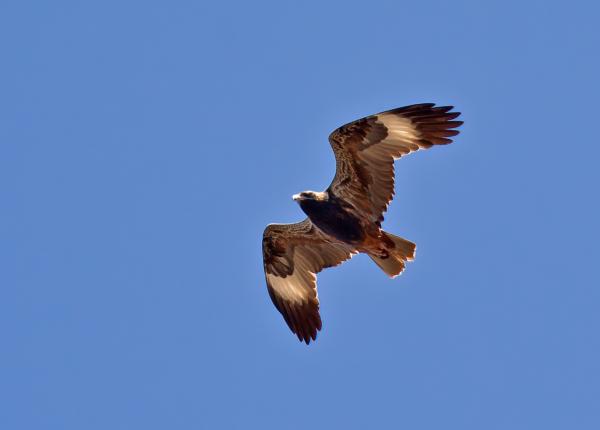How The Peregrine Fund is Helping
The Peregrine Fund is not working directly with Black-breasted Kites, but our conservation efforts through habitat protection, education, and community outreach extend to all raptor species, including this owl. We also supply literature to researchers from our avian research library, which helps scientists around the world gather and share important information on raptor conservation. We also have created the Global Raptor Impact Network, which gives raptor researchers tools to more efficiently conduct their own studies while contributing to a global program. GRIN also provides citizen scientists a way to participate in raptor science and conservation.
Where They Live
The Black-breasted Kite is lives in Australia. It inhabits a number of different habitats including riverine and open woodland, savannas, plains, and even deserts. It can be found from zero to about 1,000 meters above sea level.
What They Do
This gorgeous raptor spends a lot of time soaring high on upswept wings over open plains. It is generally a solitary bird, but it might congregate in larger numbers at carrion or eggs of large, ground-nesting birds.
Why They Need our Help
The Black-breasted Kite is categorized as Least Concern. In some parts of its range, it has probably benefited from the introduction of rabbits and the increase in carrion. However, researchers have found that some populations are declining in parts of its range as a result of clearing and degradation of habitat, the decline or extinction of native prey animals, and the poisoning of carcasses. In other areas, this bird is sometimes accidentally killed while scavenging on roads. It is also subject to illegal egg collecting.
What They Eat
This raptor will prey on a large array of different animals including mammals, such as young rabbits, reptiles, large insects, carrion and birds. In fact, when hunting other birds it seems to prefer feeding on nestlings and the contents of large eggs, which it breaks with a rock thrown from the bill or by knocking it with its beak.
It uses many hunting techniques, including by flying fast search for prey at moderate heights or by flying low and slowly, swooping down to snatch prey from trees or to seize it on the ground.
Nests, Eggs, and Young
The female will lay eggs generally sometime between September and December. The pair will construct a large nest platform made up of sticks, which they line with green leaves. The female will lay between one to three eggs, and they will need to be incubated for around 35 days before the young hatch. When they do, they will be covered in fluffy white down. In just 70 days or so, they will have grown and developed enough to be ready to make their first flights from the nest. However, usually only one nestling survives to fledging. After it has flown from the nest for the first time, it will remain with its parents for around 2 more months as it learns to hunt, avoid danger, and otherwise survive on its own.
Black-breasted Kites can begin to breed when they are only two years old.
Black-breasted Kite and the World Center for Birds of Prey
The World Center for Birds of Prey offers fun ways to learn about all birds of prey. Interactive activities, tours, interesting videos, and a children's room with activities from coloring sheets to quizzes to costumes await you. The visitor center has many live raptors on display, and in the fall you can observe some of the raptors showing off their flying skills during our Fall Flight Shows. This is a great chance to see birds of prey up close and learn about the wonderful and interesting adaptations they have in order to survive in their respective habitats. There is also a touch table with feathers and other natural objects available for exploration. Our knowledgeable staff is on hand year-round to answer any questions you may have about the Black-breasted Kite or any other bird of prey.
References:
Debus, S., P. F. D. Boesman, and J. S. Marks (2020). Black-breasted Kite (Hamirostra melanosternon), version 1.0. In Birds of the World (J. del Hoyo, A. Elliott, J. Sargatal, D. A. Christie, and E. de Juana, Editors). Cornell Lab of Ornithology, Ithaca, NY, USA. https://doi.org/10.2173/bow.bkbkit1.01
Global Raptor Information Network. 2022. Species account: Black-breasted Buzzard Hamirostra melanosternon. Downloaded from http://www.globalraptors.org on 28 Oct. 2022









